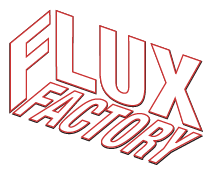Queens Chronicle – Feb 2003

Flux Factory Takes Its Art To The Streets
by Paul Menchaca,
February 27, 2003
The Long Island City art collective known as Flux Factory is pushing boundaries in pursuit of public art.
For a group of artists who once took over a wing of the Queens Museum of Art, taking over a New York City street is the next logical step. “Miracle on 43rd Street,” a project by the Long Island City art collective known as Flux Factory, opens on April 26th, and could arguably be the most ambitious endeavor Flux Factory has taken on up to this point.
Setting out to change a nondescript Queens street into a Wizard of Oz world where everything is no longer what it once seemed, requires the imagination to toy with reality, and the ability to convince the public to lose itself in this new landscape.
This latest project, which Flux Factory will work to set up throughout March, continues the movement by this group to bring art to the streets, and to build a name in an area that still operates under the radar of New York City’s cultural scene.
Flux Factory is a 15-member collective that formed in 1994 in Williamsburg, Brooklyn, before that neighborhood became the ultra-hip New York place-to-be that it is now. Faced with an eviction so that their loft could be changed into higher-priced condos, the members looked elsewhere for a home.
After exhausting the search in Brooklyn, they turned their sights to Long Island City, when they heard about the space at 38-38 43rd Street. Their loft is located at a dimly-lit spot on the street, but offers a spectacular view of the city. Although their old neighborhood has undergone a gentrification-supported renaissance that is bustling with hipper-than-thou young artists and bohemians, the members of Flux Factory are glad to be in Queens now.
“The art scene is fresher, there is less competition,” 24-year-old Flux Factory curator Jean Barberis said. “The hipsters are definitely moving in (to Long Island City), but I don’t think a lot of people really expect an art collective to be here. It’s not at all hyped, which gives us more freedom.” The collective gained some notice this past summer with its project, “When Everybody Agrees It Means Nobody Understood,” which was part of the Queens International show at the Queens Museum of Art in Flushing. Recreating their art loft inside of the museum, the Flux Factory members dressed in matching orange jumpsuits, made daily visits for ribbon cuttings, to make alterations, record its progress and even have tea with museum visitors. “I think some people were completely baffled by us, some people were even annoyed by us,” said Stefany Anne Golberg, 29, who is the group’s director of events.
Flux Factory encompasses a diverse group of writers, visual artists, musicians and even a soon-to-be doctor of philosophy, as Morgan Meis, president of the collective, is working toward his Ph.D. at the New School. It is an international collective, with members coming from all over the country and world – Barberis and Sanz de Santamaria are from France, Golberg is a native of Las Vegas.
“The people working on these projects aren’t self-proclaimed artists,” said Sanzde Santamaria, 25, who is the art director for Flux Factory. “There are no pretensions, there’s only the enthusiasm and pleasures of venturing into unknown realms.”
Golberg believes the diverse backgrounds of its members allows for everyone to be influenced by each other.
“I think as a group the focus is less on specific medias and more on ideas,” she said. “Although we are all coming from different places in one sense, there is a common ground, and I think that’s where the ideas come from.”
Barberis sees the group as being a “big think tank,” in which the members have “endless conversations” about what art is. “We are hardly interested in creating objects. We’d rather play mental ping-pong. We like to bounce ideas off each other.”
Golberg also stressed the importance of the non-profit nature of the collective. The group hopes to make Flux Factory a place that supports outside artists who are not necessarily supported by the mainstream.
This would mean not only making their space available for shows, but also providing the means for artists to get their work done with the use of the space’s darkroom, as well as the planned media center and recording facilities that would also be a part of the loft. They are also talking about starting an international artist-in-residency program, as well as workshops for kids.
Golberg indicated that, although the collective is interested in the New York art scene, the members do not want to be “beholden” to it. “Having our own space is very key to being able to do that,” she said. “If we want to show our art, we don’t have to be dependent on another gallery.” The group has taken advantage of the burgeoning art world in their Queens neighborhood: The first show at the Flux Factory art space in Long Island City was on the same day that MoMA QNS. officially opened at its temporary home on 33rd Street.
However, Flux Factory seems less interested in fitting into the art scene in New York City, than in creating art that does not need to be trapped in galleries.
“I think perhaps the thing that will keep us both isolated from the New York art world, and also very much a part of it, and a part of New York itself, is continuing to bring our art into the streets of the city and to become more and more about public art,” Golberg said.
For more information about Flux Factory, visit www.fluxfactory.org.
©Queens Chronicle – Mid Edition 2003
